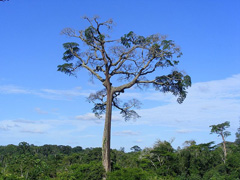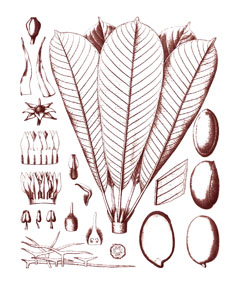 |
|
Jabea Tongo Etonde |
 |
| https://edibleplants.org/ |
Translate this page:
Summary
African Pearwood (Baillonella toxisperma), otherwise known as False Shea Butternut, is a large, tropical tree that can reach up to 60 m high with a trunk diameter of up to 300 to 500 cm. It has a straight and cylindrical bole, alternately arranged leaves, and round fruits. In traditional medicine, the seed kernel of this plant is used for its fatty oil content to treat rheumatism. In particular, the oil is applied externally to the pained area caused by such ailment. Decoctions of the bark are used against kidney conditions, tooth pain, rickets, vaginal infections, and problems in respiratory and digestive tracts. The fruit pulp, though it contains latex, is eaten fresh. The fatty oil obtained from the seeds is also used in cooking. It is also used as pomade to the hair and in soap making. The wood is heavy, hard, elastic, and very durable. Not to be confused with Dacryodes edulis, the African pear.
Physical Characteristics

 Baillonella toxisperma is a deciduous Tree growing to 50 m (164ft) by 40 m (131ft) at a fast rate.
Baillonella toxisperma is a deciduous Tree growing to 50 m (164ft) by 40 m (131ft) at a fast rate.
See above for USDA hardiness. It is hardy to UK zone 10.
Suitable for: light (sandy), medium (loamy) and heavy (clay) soils and prefers well-drained soil. Suitable pH: mildly acid, neutral and basic (mildly alkaline) soils and can grow in very acid and very alkaline soils.
It can grow in semi-shade (light woodland) or no shade. It prefers moist soil.
UK Hardiness Map
US Hardiness Map
Synonyms
Baillonella djave (Engl.) Pierre ex Dubard. Baillonella pierriana (Engl.) A.Chev. Mimusops djave Eng
Plant Habitats
Edible Uses
Edible Parts: Fruit Oil Seed
Edible Uses: Oil
Edible portion: Nut, Seeds - oil, Fruit. The fruit pulp is eaten fresh although it contains latex[ 299 , 317 ]. The seed kernel contains a fatty oil that is used in cooking[ 299 , 317 ]. The residue after extracting the oil is toxic.
References More on Edible Uses
Medicinal Uses
Plants For A Future can not take any responsibility for any adverse effects from the use of plants. Always seek advice from a professional before using a plant medicinally.
Antirheumatic Kidney Odontalgic Pectoral
The seed kernel contains a fatty oil that is used in traditional medicine[ 299 ]. It is applied externally to treat rheumatic pains[ 299 ]. Bark decoctions are used to treat kidney problems, toothache, rickets, vaginal infections and affections of the respiratory and digestive tracts[ 299 ].
References More on Medicinal Uses
The Bookshop: Edible Plant Books
Our Latest books on Perennial Plants For Food Forests and Permaculture Gardens in paperback or digital formats.

Edible Tropical Plants
Food Forest Plants for Hotter Conditions: 250+ Plants For Tropical Food Forests & Permaculture Gardens.
More

Edible Temperate Plants
Plants for Your Food Forest: 500 Plants for Temperate Food Forests & Permaculture Gardens.
More

More Books
PFAF have eight books available in paperback and digital formats. Browse the shop for more information.
Shop Now
Other Uses
Hair Oil Soap making Wood
Other uses rating: High (4/5). Other Uses The seed kernel contains a fatty oil that is used as a pomade to the hair and also in soap manufacture[ 299 , 317 ]. The allelopathic compound 3-hydroxyuridine has been isolated from the leaves, stems and roots of the tree[ 299 ]. It inhibited the growth of seedlings of some test plants[ 299 ]. The heartwood has a uniform reddish brown colour, more or less dark and finely veined; it is clearly demarcated from the 4 - 6cm wide band of sapwood. The texture is fine; the grain straight or interlocked. The wood is heavy, hard, elastic, very durable, with a resistance to fungi, Lyctus beetles, termites and marine borers. It is difficult to work due to the presence of silica (0.2 - 0.3%) - power tools that are stellite-tipped and tungsten carbide are recommended; it glues correct, though care needs to be taken because of the density of the wood; it takes nails and screws well, but pre-boring is required; it finishes well; and has good steam-bending properties. Painting and varnishing with the principal industrial products do not cause problems. It is used for many purposes including high class cabinetwork, joinery and carpentry in both interior and exterior applications, marine construction, flooring, turnery, railway sleepers, decorative uses and veneer[ 299 , 848 ].
Special Uses
Food Forest
References More on Other Uses
Cultivation details
The tree occurs in primary rain forest in humid and warm climates, with a mean annual temperature of 23 - 26°c and a mean annual rainfall of 1,500 - 3,000 mm[ 299 ]. Seeds germinate in abundance under or close to mother trees. However, young plants of 1 metre tall are rare as a result of predation by animals, mainly elephants, and the survival rate of seedlings after 18 months is practically nil under the mother tree and very low (less than 2%) elsewhere[ 299 ]. In forest undergrowth seedlings grow 4 - 5 cm/year. They respond rapidly to the opening of the forest cover and direct sunlight, and under these circumstances may grow up to 40 cm/year. When the tree bole has attained 1m in diameter and the crowns have reached or passed the forest canopy, diameter growth is up to 9.5 mm/year. It has been estimated from growth rings and C14 dating that a tree with a bole diameter of 1 metre was 260 years old and one with a diameter of 2.8 metres 600 - 700 years[ 299 ]. The tree starts flowering at an age of 50 - 70 years, when it has reached the light in the upper storey of the forest, but regular fructification starts still later, when the bole has reached 70 cm in diameter[ 299 ]. Fruits are produced annually, but mass production occurs once in 3 years. About 6,000 seeds per tree are produced within a cycle of 3 years; a single tree produced 2,460 kg of fruits, including 327 kg of seed kernels[ 299 ]. The fruiting season lasts up to 4 weeks for an individual tree, but may last 3 months for a whole wild population[ 299 ]. At present, the only management measure for natural forest is the maintenance of a minimum diameter limit for exploitation, i.e. 70 cm in Gabon, 80 cm in Congo and 100 cm in Cameroon. In Cameroon commercial exploitation of the tree implies the cutting of 90% of trees above 100 cm in diameter, leaving only poorly shaped trees. It has been estimated that after 300 years 84% of the harvested volume is re-established and after 500 years 92%. Sustainable production in natural forest is therefore not possible. Cutting cycles of 30 years, as often practised, threaten the populations seriously[ 299 ]. During the fruiting season, local people often move to localities where clusters of trees are found and stay there in temporary camps for 2 - 8 weeks. The collected fruits are depulped and the seed kernels dried. After heating, the oil is gathered by pressing with a traditional wooden press. The oil is used domestically or sold. It can be stored for 1 - 2 years[ 299 ]. In 1992, which was a very good year for fruit production, the yield of oil was estimated at 135 - 165 litres per adult tree[ 299 ].
References Carbon Farming Information and Carbon Sequestration Information
Temperature Converter
Type a value in the Celsius field to convert the value to Fahrenheit:
Fahrenheit:
The PFAF Bookshop
Plants For A Future have a number of books available in paperback and digital form. Book titles include Edible Plants, Edible Perennials, Edible Trees,Edible Shrubs, Woodland Gardening, and Temperate Food Forest Plants. Our new book is Food Forest Plants For Hotter Conditions (Tropical and Sub-Tropical).
Shop Now
Plant Propagation
Seed. Shade is required for germination, which usually takes 1 - 4 weeks[ 299 ]. The germination capacity of fresh seeds is high (> 85%), but drops rapidly to 5% after 6 weeks of storage due to rapid degradation of the fatty acids[ 299 ]. However, fresh seeds stored at 4?C and humid conditions still showed a germination rate of about 50% after 11 months[ 299 ]. In the nursery the lower half of the seed is buried, with the scar pointing downwards. The mortality of seedlings in the nursery is very low. Partial shading is favourable for seedling development. Under optimal nursery conditions seedlings may reach 35 cm in height after 6 weeks, 45 cm after 3 months and 1.5 metres after 18 months[ 299 ]. The seedling develops a taproot and so it is recommended to sow into polythene pots. Seedlings are planted out into the field, when about 4 - 5 months old, at the start of the rainy season under the light shade of about 10 retained adult trees per ha. The shade should be removed gradually when a reduction in diameter growth is observed[ 299 ]. Seeds germinate in abundance under or close to mother trees - whilst it is not necessary for the seeds to pass through the intestines for germination, it does accelerate germination slightly[ 299 ].
Other Names
If available other names are mentioned here
African Pearwood (Baillonella toxisperma), otherwise known as False Shea Butternut. Not to be confused with Dacryodes edulis, the African pear. Other Names: Adjap, Adza, Djave Nut Gio, Mabi, Moabi, Njabi, Njap, Oko uku.
Native Range
AFRICA: Central African Republic, Cameroon, Democratic Republic of the Congo, Congo, Gabon, Nigeria (southeast), Angola
Weed Potential
Right plant wrong place. We are currently updating this section.
Please note that a plant may be invasive in one area but may not in your area so it's worth checking.
None Known
Conservation Status
IUCN Red List of Threatened Plants Status : Vulnerable

Growth: S = slow M = medium F = fast. Soil: L = light (sandy) M = medium H = heavy (clay). pH: A = acid N = neutral B = basic (alkaline). Shade: F = full shade S = semi-shade N = no shade. Moisture: D = dry M = Moist We = wet Wa = water.
Now available:
Food Forest Plants for Mediterranean Conditions
350+ Perennial Plants For Mediterranean and Drier Food Forests and Permaculture Gardens.
[Paperback and eBook]
This is the third in Plants For A Future's series of plant guides for food forests tailored to
specific climate zones. Following volumes on temperate and tropical ecosystems, this book focuses
on species suited to Mediterranean conditions—regions with hot, dry summers and cool, wet winters,
often facing the added challenge of climate change.
Read More
Expert comment
Author
Pierre
Botanical References
Links / References
For a list of references used on this page please go here
A special thanks to Ken Fern for some of the information used on this page.
Readers comment
| Add a comment |
|
If you have important information about this plant that may help other users please add a comment or link below. Only comments or links that are felt to be directly relevant to a plant will be included. If you think a comment/link or information contained on this page is inaccurate or misleading we would welcome your feedback at [email protected]. If you have questions about a plant please use the Forum on this website as we do not have the resources to answer questions ourselves.
* Please note: the comments by website users are not necessarily those held by PFAF and may give misleading or inaccurate information.
To leave a comment please Register or login here All comments need to be approved so will not appear immediately.
|
Subject : Baillonella toxisperma
|
|
|
|